Wednesday, 26 June, Cochem Reichsburg Castle, city tour, and wine tasting, without bicycles or kayaks
Written 5 August 2019
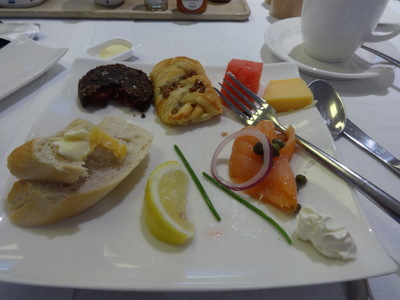
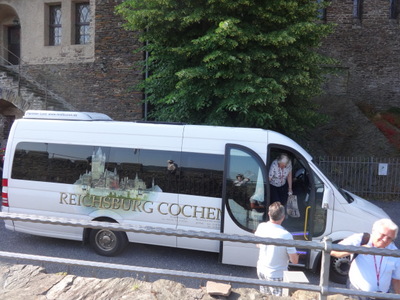 As scheduled, the Kvasir docked in Cochem at 7 a.m., just as breakfast opened. Here's my breakfast plate (well, one of them), bearing, clockwise from 12 o'clock, a little red fruit pastry (not as good as it looked); some watermelon; a piece of cheese; some smoked salmon with capers, red onion, cream cheese, chives, and lemon; some bread and butter to go with the cheese, and, the prize of the lot, a fat slice of blutwurst—blood sausage—crisped on the griddle. Boy was that good! I'm glad I went back for more, because it never showed up again. You can also see the single-serve little plastic tub out of which I had to pry my butter. Now why would an organization that provides smoked salmon ad lib, morning after morning, be so miserly with butter? At dinner, each table for four was provided with four neat pats of butter on a plate, garnished with a rosemary sprig; at least they weren't plastic-wrapped.
As scheduled, the Kvasir docked in Cochem at 7 a.m., just as breakfast opened. Here's my breakfast plate (well, one of them), bearing, clockwise from 12 o'clock, a little red fruit pastry (not as good as it looked); some watermelon; a piece of cheese; some smoked salmon with capers, red onion, cream cheese, chives, and lemon; some bread and butter to go with the cheese, and, the prize of the lot, a fat slice of blutwurst—blood sausage—crisped on the griddle. Boy was that good! I'm glad I went back for more, because it never showed up again. You can also see the single-serve little plastic tub out of which I had to pry my butter. Now why would an organization that provides smoked salmon ad lib, morning after morning, be so miserly with butter? At dinner, each table for four was provided with four neat pats of butter on a plate, garnished with a rosemary sprig; at least they weren't plastic-wrapped.
At the appointed hour of 8:30 a.m., we presented ourselves at reception to pick up our landing cards, armed with our Quietvoxes (every evening, we placed them in their charging slots, so their batteries would be ready to go in the morning). According to our group cards, we were either sent off on foot to tour the town or (in our case) ushered into small white shuttle buses provided by the management of the Reichsburg Castle and driven up the rather steep hill to the castle, on its pinnacle above the town. While we were touring the town later, the other groups were in turn touring the castle.
The imperial castle (that's what "Reichsburg" means) was first mentioned in documents in 1130 AD, but nobody ever told us when it was actually built. It sat there being imperial until Louis XIV came through in 1688, as usual withdrawing within a year and tearing the castle down as he left. After that it remained a ruin until a Frenchman named Louis Ravené (a Huguenot who married big money) bought it in 1866 and restored it to all it's present positively comic-opera Germanness.
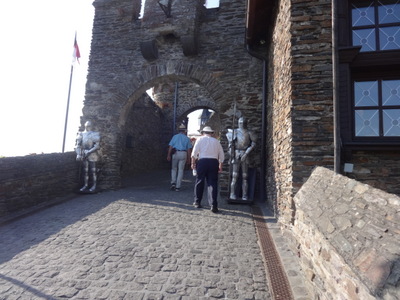
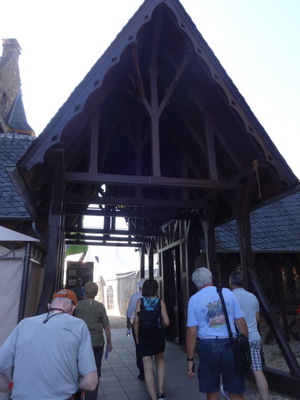 Even after the bus ride up the hill, we still had to climb a good way up this stone ramp (of which you can only see part; it had a couple of switchbacks in it), past two coats of armor guarding the archway, past several gardeners industriously planting colorful flowers, and finally in through this covered wooden door to the courtyard.
Even after the bus ride up the hill, we still had to climb a good way up this stone ramp (of which you can only see part; it had a couple of switchbacks in it), past two coats of armor guarding the archway, past several gardeners industriously planting colorful flowers, and finally in through this covered wooden door to the courtyard.
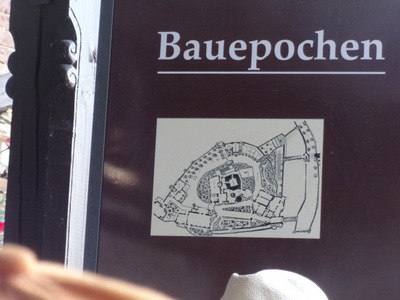
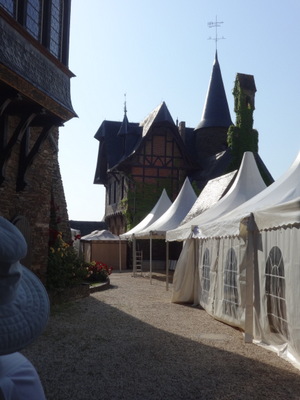 Here's the floorplan and map the guide pointed out. The place is a very complicated shape and includes many changes in elevation. I think the bus dropped us at the lower right corner and that we climbed to the left, then switched back to the right, and finally bore left through the wooden arch.
Here's the floorplan and map the guide pointed out. The place is a very complicated shape and includes many changes in elevation. I think the bus dropped us at the lower right corner and that we climbed to the left, then switched back to the right, and finally bore left through the wooden arch.
As you can see at the left, much of the courtyard was taken up with white tents being set up for a gourmet festival coming up in two weeks (sold out a year ago, according to the guide); the new bedding plants were a propos of the same event.
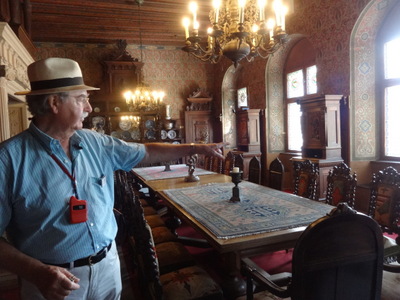
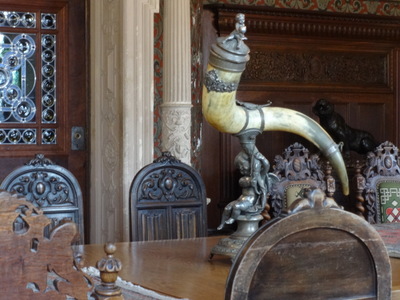 The indoor tour started with this dining room. Note the heavy ornately carved chairs, the china cupboard at the far end, the painted wooden ceiling reminiscent of that at Wakulla Springs Lodge, and particularly the drinking horn on the center of the table.
The indoor tour started with this dining room. Note the heavy ornately carved chairs, the china cupboard at the far end, the painted wooden ceiling reminiscent of that at Wakulla Springs Lodge, and particularly the drinking horn on the center of the table.
The horn is obscured by the guide's outstretched arm in the left-hand shot, but here's a closer photo of it. People apparently actually did drink out of these things, at least on ceremonial occasions, but I was glad to learn they are lined with metal inside. The guide told us that Germany is second only to Czechoclovakia in per-capita beer consumption.
The sunny windows look out over the town and the river.
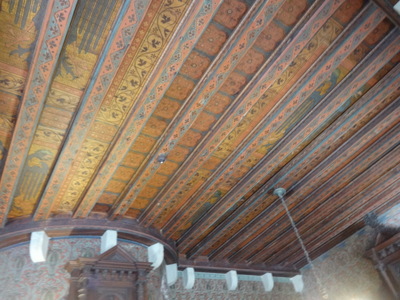
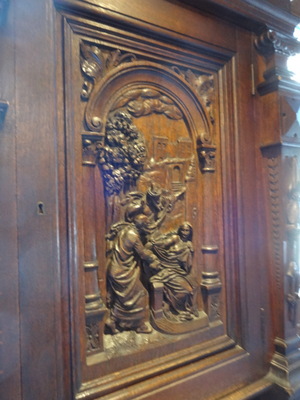 Here's a better view of the ceiling. No egrets or blue herons on it, but you can see the kinship with the Wakulla ceiling.
Here's a better view of the ceiling. No egrets or blue herons on it, but you can see the kinship with the Wakulla ceiling.
At the right is a not-very-good shot of one of the many carved wooden door panels throughout the house.
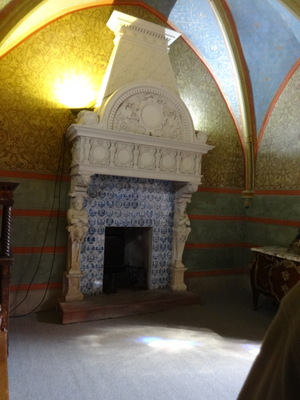
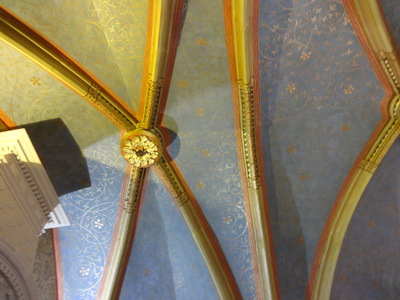 The next room had no furniture in it, but it featured this fireplace with a Gothic style mantlepiece and Delft tiles that are over 150 years old.
The next room had no furniture in it, but it featured this fireplace with a Gothic style mantlepiece and Delft tiles that are over 150 years old.
The vaulted ceiling was pale blue to go with the tiles, and both it and the golden walls had a fine tracery of tiny flowers painted all over them.
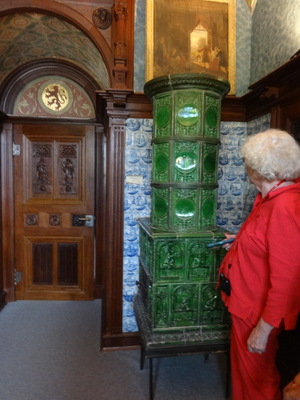
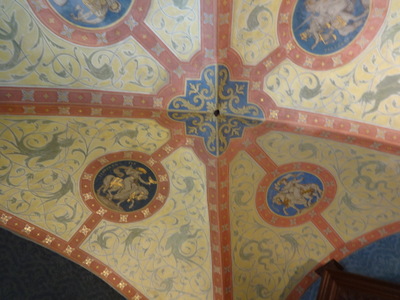 Another room featured this green tiled stove (I think he said Nuremberg style?), with more Delft tiles on the wall behind it to protect the wall from the heat. It was on four legs and didn't actually touch the wall. It seemed to be stoked through a little metal door near the bottom on the left-hand side rather than from behind through the wall, like some we've seen.
Another room featured this green tiled stove (I think he said Nuremberg style?), with more Delft tiles on the wall behind it to protect the wall from the heat. It was on four legs and didn't actually touch the wall. It seemed to be stoked through a little metal door near the bottom on the left-hand side rather than from behind through the wall, like some we've seen.
This room's vaulted ceiling had yet another pattern of decorative painting.
Above one of the doorways we passed through was carved "You shouldn't expect usefulness from something built for beauty."
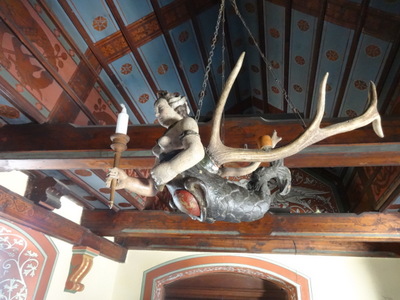
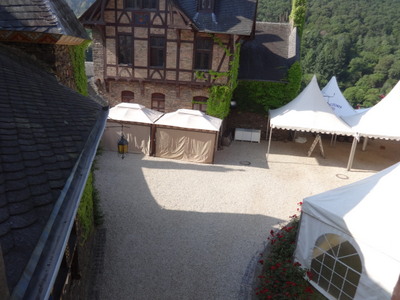 Under a barrel-vaulted wooden ceiling hung this remarkable object. There used to be one in a German restaurant in Chapel Hill, and we've seen several in other castles we've toured over the years. Her presence is supposed to ward off evil and protect the castle, but I've never really understood the concept. Why a mermaid with antlers? And why are the antlers attached at her hips rather than on her head or even shoulders? Bizarre? Any of you readers out there have a clue?
Under a barrel-vaulted wooden ceiling hung this remarkable object. There used to be one in a German restaurant in Chapel Hill, and we've seen several in other castles we've toured over the years. Her presence is supposed to ward off evil and protect the castle, but I've never really understood the concept. Why a mermaid with antlers? And why are the antlers attached at her hips rather than on her head or even shoulders? Bizarre? Any of you readers out there have a clue?
At the right here is a view down into the courtyard from one of the rooms we passed through.
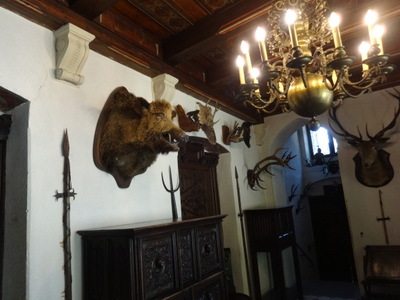
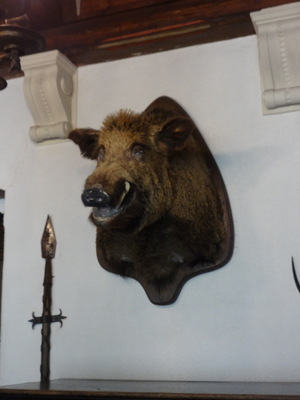 The trophy room contained large number of mounted heads and disembodied antlers, some quite large like the wild boar at the right, and others not, like the tiny stuffed weasel, smaller than a squirrel.
The trophy room contained large number of mounted heads and disembodied antlers, some quite large like the wild boar at the right, and others not, like the tiny stuffed weasel, smaller than a squirrel.
In a separate little room off the main trophy room were a few stuffed birds, including one very large one. The guide asked whether we knew what it was. After some ridiculous guesses fom my fellow passengers, like "turkey" and"condor," I said, "It looks like a grouse, but a really big one. The guide revealed that it's an "auerhahn," a capercaillie (Tetrao urogallus)), the largest member of the grouse family, and quite a trophy! I had no idea they got that big.
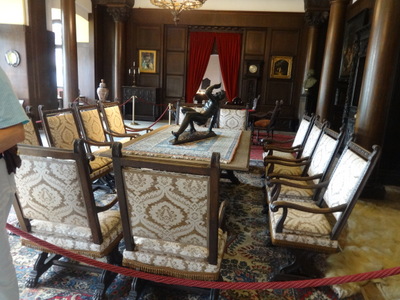
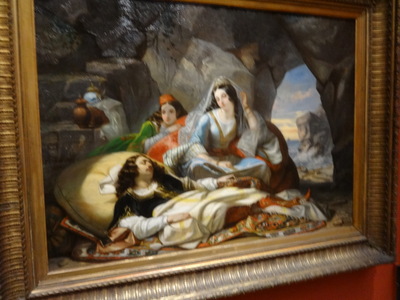 In another room furnished for dining was this much more modern-looking arrangement of table and chairs.
In another room furnished for dining was this much more modern-looking arrangement of table and chairs.
The photo on the right is of the sculpture on the table. I think it was in that room that we saw a marble bust of Louis Ravané, restorer of the castle.
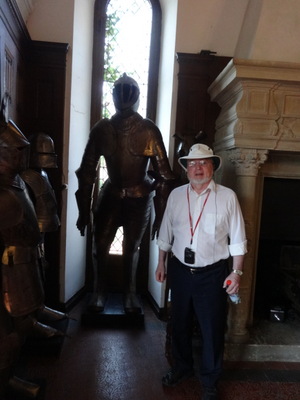
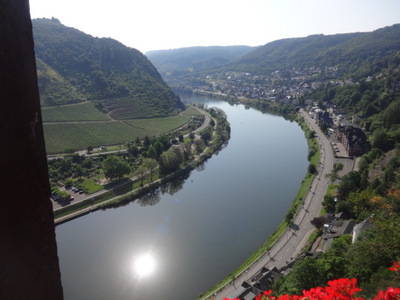 In the smoking room, distinguished by its tiled rather than wooden or carpeted floor, was this huge suit of armor, 50% bigger than any of the others. The guy wearing it would have been 2 m 38 cm (7.8 ft!) tall. The guide told us that the military salute derives from the gesture of raising the visor of your helmet. The smoking room also included a 16th-century marquetry wardrobe in blond wood. Beautiful.
In the smoking room, distinguished by its tiled rather than wooden or carpeted floor, was this huge suit of armor, 50% bigger than any of the others. The guy wearing it would have been 2 m 38 cm (7.8 ft!) tall. The guide told us that the military salute derives from the gesture of raising the visor of your helmet. The smoking room also included a 16th-century marquetry wardrobe in blond wood. Beautiful.
Out on one of the balconies, we had this beautiful view of the river below. From a different angle, we could see our ship, moored down in the town.
Written 6 August 2019
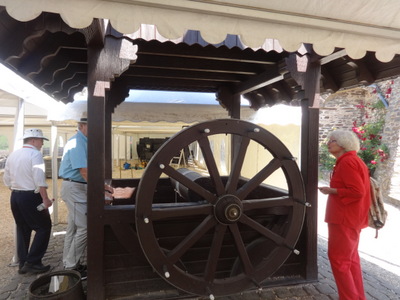
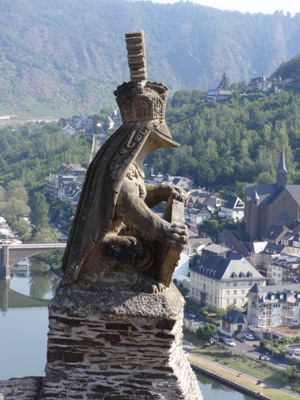 The castle has over 40 rooms, of which we visited only 7. On our way out through the courtyard, we stopped to look at the well (essential, of course if the castle were to withstand sieges). It was dug 1000 years ago, through solid slate, and is 5 m deep.
The castle has over 40 rooms, of which we visited only 7. On our way out through the courtyard, we stopped to look at the well (essential, of course if the castle were to withstand sieges). It was dug 1000 years ago, through solid slate, and is 5 m deep.
As we passed out through the exit the guide assured us that this figure is not Kermit the Frog but a lion in armor with his visor closed. Near the small of his back you can see a bridge and the Kvasir, is moored just beyond it. To get on the buses, we stepped ashore, doubled back to walk over the bridge, and found the shuttle bus waiting for us on the castle side. According to the guide, during WWII, the allies tried to bomb the bridge, but they missed and hit the town instead, blowing the glass out of the castle's windows but not otherwise damaging it.
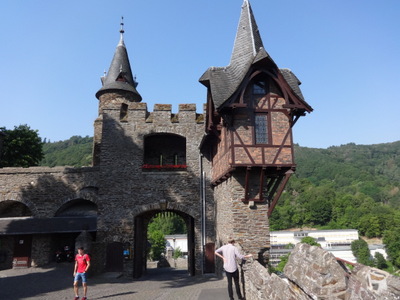
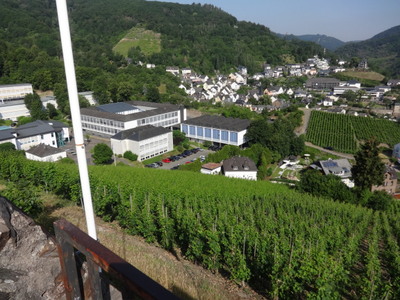 In other directions were this picturesque view of a wing of the castle and the view of the town's technical high school, on the hillside below the castle. We were told that a school bus runs up and down the river picking up students but that it drops them off down in the town and the students have to climb the hill on foot to get to classes.
In other directions were this picturesque view of a wing of the castle and the view of the town's technical high school, on the hillside below the castle. We were told that a school bus runs up and down the river picking up students but that it drops them off down in the town and the students have to climb the hill on foot to get to classes.
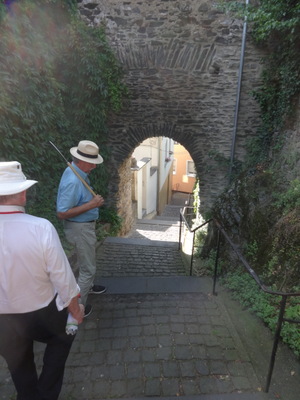
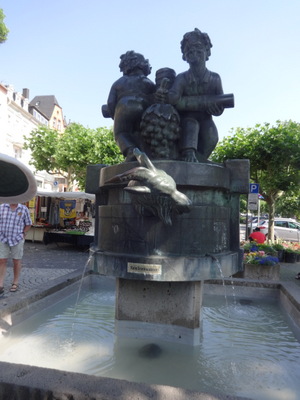 The bus took us partway down the hill, but the walking tour of the town on the way back to the ship still tool us down some impressive slopes, like this "street." Cochem still has its medieval-era walls, so as you walk around in it, you pass through quite a lot of gates in it. That's one partway down the stairs.
The bus took us partway down the hill, but the walking tour of the town on the way back to the ship still tool us down some impressive slopes, like this "street." Cochem still has its medieval-era walls, so as you walk around in it, you pass through quite a lot of gates in it. That's one partway down the stairs.
At the left is a fountain commemorating an event described in a book of short funny poems, the relevant one of which is inscribed around the base of the fountain (although the little sign you can see in my photo just says "nonpotable water"). Apparently, a goat was convicted of eating white grapes and was sentenced to be pressed in a wine press. Here you see two men gleefully pushing the windlass to tighten the press on him, while his head sticks out in the foreground. The goat was proven innocent, though, because the juice that ran out was red rather than white.
The "little white trains" in Cochem were an exception to the German pattern—they were yellow and green.
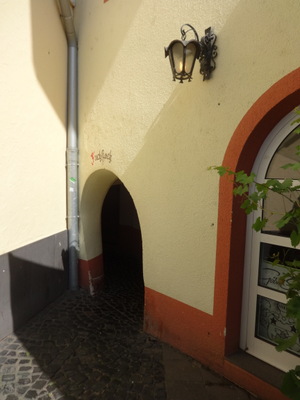
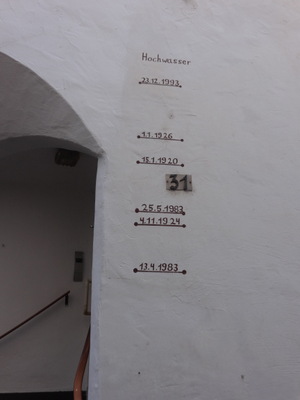 At the left here is the "Fuchlach," the foxhole, the smallest gate in the town's walls. To reach the street on the other side, we had to duck through it and an short curved tunnel.
At the left here is the "Fuchlach," the foxhole, the smallest gate in the town's walls. To reach the street on the other side, we had to duck through it and an short curved tunnel.
At the right is a series of high-water markers. The most recent one here is the top one—23 December 1993.
Among the spots the guide pointed out in town were a half-timbered house dating from 1704 facing one across the street that dates only from 1948, the oldest weinstub (wine bar) in town (1642), a tower with a triple onion dome that was only finished in 1953, and a statue in the market square of St. Martin, the town's patron saint, sharing his cloak with a beggar. The guide also told us that a church with a rooster on the steeple is Catholic and one with a plain cross is protestant, though I'm not sure that was universally true.
He was also able to tell me the German name of the common sparrow (Passer domesticus). Formally, it's "sperling" or "hassperling," but casually, it's "spatz."
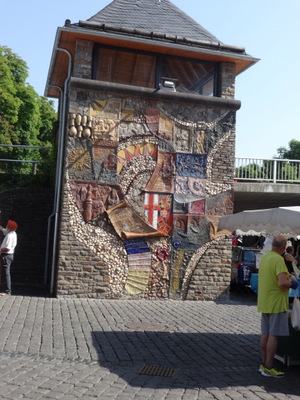
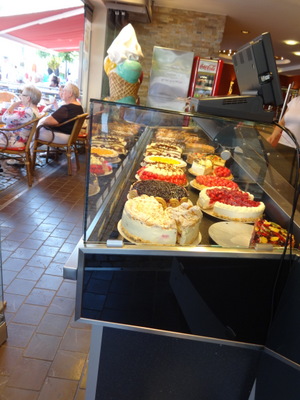 Near the end of the tour was this magnificent 1982 sculpture/mosaic of the town's time line. My photo is way to small to show the details, but inscriptions in the clay explain the parts. At the top, for example, one says "Celts, Romans, Franconians" and names four Roman legions that were apparently garrisoned here. You can see some Roman amphorae near the top left.
Near the end of the tour was this magnificent 1982 sculpture/mosaic of the town's time line. My photo is way to small to show the details, but inscriptions in the clay explain the parts. At the top, for example, one says "Celts, Romans, Franconians" and names four Roman legions that were apparently garrisoned here. You can see some Roman amphorae near the top left.
Partway down is an image of the castle (to the left of the blue rectangle) with a series of owners and their dates—1020, Pfalzgraf Ehrefried; 1689, destruction; 1877, Louis Ravené reconstruction; 1978, City of Cochem.
At the bottom, in the multicolored "tail" below the scroll is a list of the various governments the town has been under, from the Archbishop of Trier in 1512 to Rhineland Pfalz Bundesland in 1949. These are just some highlights of the rich abundance of detail you can see up close.
At the right is a bakery display case that happened to have a particularly spectacular display of cakes.
At the end of the walking tour, we again settled on a café terrace for a beer and a water before meeting the Viking bus for a scenic drive to another wine tasting.
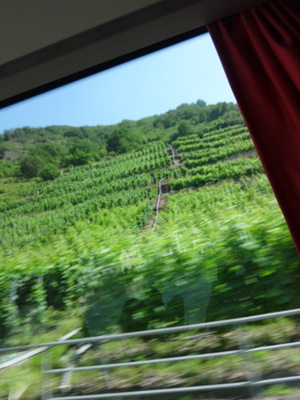
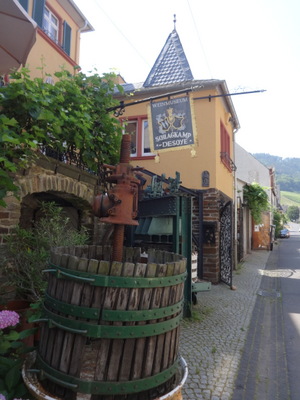 On the way, our Viking guide pointed out an innovaion in the vineyards. They are so steep that all the work of pruning, harvesting, etc. must be done by hand, but in some areas, the growers have installed what you see here at the left—little monorails that can be used to haul equipment (and presumably filled bins of harvested grapes) up and down the hills.
On the way, our Viking guide pointed out an innovaion in the vineyards. They are so steep that all the work of pruning, harvesting, etc. must be done by hand, but in some areas, the growers have installed what you see here at the left—little monorails that can be used to haul equipment (and presumably filled bins of harvested grapes) up and down the hills.
The tasting was at the Schagkamp Weinmuseum in Senheim. On display outside were many, many pieces of disused wine-making apparatus.
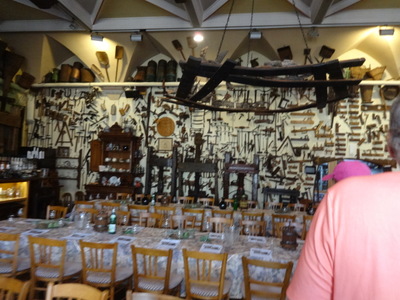
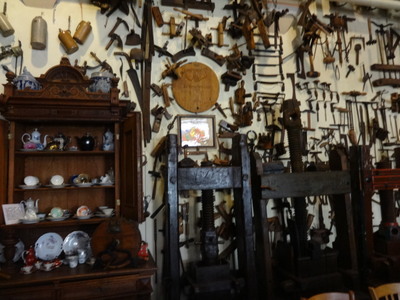 Inside were even more! Every room we were shown was entirely wallpapered in antique grape-growing and wine-making tools! I love that kind of thing, and I wish we'd had time to look at them all, read the labels, and ask questions.
Inside were even more! Every room we were shown was entirely wallpapered in antique grape-growing and wine-making tools! I love that kind of thing, and I wish we'd had time to look at them all, read the labels, and ask questions.
The room shown at the left was the tasting room, where we were seated at long tables to taste four Reisling wines and a peach liqueur. As usual, they started with the dry wines and worked up to the sweeter; the last was almost tolerable if sipped very slowly.
The liqueur was fabulous. It was made from "pêches de vigne," small wild, gray-skinned, red-fleshed peaches that grow only in Burgundy, Moselle, Luxembourg, and Belgium. It's made by maceration rather than fermentation—that is, the mashed peaches are macerate with alcohol and sugar rather than being pressed and their juice fermented. It's very sweet and amazingly flavorful. I was dutifully sipping mine along with everyone else when our host (the winemaker) pointed out that it is seldom drunk straight—too expensive for one thing—instead, it is usually used to make a peach kir or kir royale. That it, a little of the liqueur is put in a glass and about four parts of white Reisling or Champagne are added. So I reached for the water pitcher and cut my liqueur four-to-one with water, and boy was that delicious!
TThe Viking folks told us that this wine maker, Andreas, is very popular with their passengers for his stand-up comedy, but I didn't think he was as funny as that guy at Quinta da Avessada in Portugal (2015 diary, 8/15 entry). He was, however, extremely informative!
He is the 11th generation of his family to make Reisling on this land (and he introduced his red-headed 8-year-old son, who will be the 12th). They've been here since 1602. When he was 16, he couldn't imagine staying on to continue the tradition. He hated Reisling; when he was in charge he was going to rip it out and plant the more fashionable Chardonnay. Now he's glad his father talked him out of it.
For a while, he explained, the only way to stop fermentation early (and therefore to make sweeter wines) was to add sulphur, and sulphur causes headaches. The modern technology is to use cooling or some other method instead. Sulphites are added to the bottle to make the wine durable, but his wine should be drunk within 5 years, becuse he ferments very slowly at low temperatures, so as not to have to add sulphites at all. He likes them filtred and very fresh, so no more oak for white wine. He doesnt use barrels. He notes that cold tames the acid in the wine.
The microclimate in his valley can grow even olives and oranges, but they have a real water shortage (not a problem for the Reisling).
It's hard to find good workers; they must be skilled enough to inspect and select the grapes. In his father's time, they used Polish workers. Now he uses locals—students, retirees, whatever—they only need about 8 workers a day. During harvest, they pass through the vineyards three times a day, harvesting only by hand. They cut the bunches with scissors, then pick them over removing bad grapes. If there are too many spoiled grapes, they throw the bunch on the ground and go on. Even a few spoiled or rotten grapes will ruin the wine. He employs only women to pick; the men carry the filled baskets back and forth. He claims that, rather than properly cutting the cluster, men cut the vine, pull it over to the basket, and strip the grapes off into it, smashing them, so that the juice begins fermenting even before it reaches the crusher. Minimum pay is 75 euros (per day?).
Harvest of some grape varieties begins in late August to early September; that for Reisling, end of September to early November. Every wine maker we talked to emphasized that they must now harvest earlier every year, because of climate change. At harvest time, some of the grapes are used to make a half-fermented grape juice, to be drunk immediately.
He adds yeast, rather than relying on the natural yeasts on the grapes. Fermentation yields more flavors and more body. This winery produces about 100,000 bottles per year. The wine-maker likes red wine, but finds he can't sleep after he drinks it. He thinks helicopters are the best thing ever to happen to wine growers; fungicides can now be sprayed on aerially rather than applied manually.
The region is divided into very small holdings, and marriages were often used to consolidate them. Whenever he went out with a girls, his grandmother reminded him that love fades but acreage lasts. "First ask her name, then whether she has a boyfriends, then how much acreage her family has!"
All of this morning's activities were included in the tour price, but if we had chosen, we could have skipped them and instead chosen one of the day's optional excursions: bicycling along the banks of the Moselle and canoeing along the Moselle. Each took the whole morning. Turns out the bikes were electric-motor assisted, and I assume they bused the canoers whichever direction was upstream. I still think we made the right choice.
Everybody had to be back on board by 1:15 p.m.
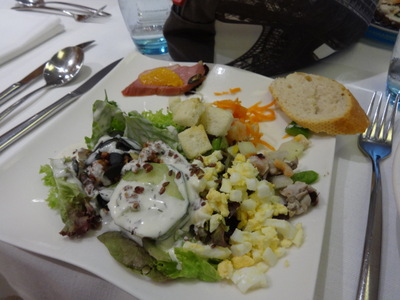
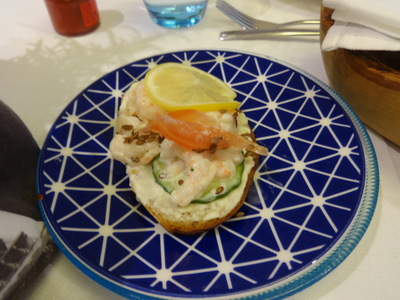 Finally, it was back into the bus for the ride back to the ship for lunch. I just had the salad bar, which included smoked duck breast with orange slices (top left corner of the plate) and slices of bread topped with cucumber and shrimp.
Finally, it was back into the bus for the ride back to the ship for lunch. I just had the salad bar, which included smoked duck breast with orange slices (top left corner of the plate) and slices of bread topped with cucumber and shrimp.
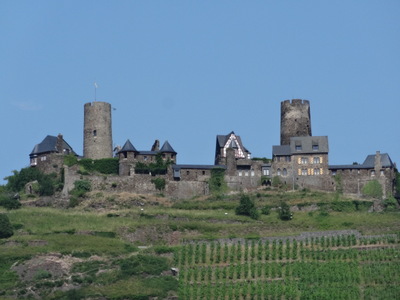
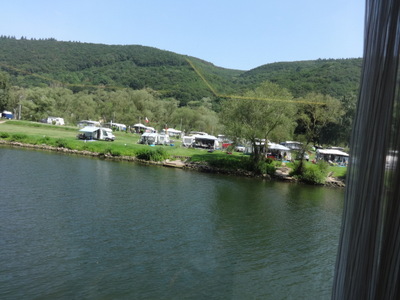 I then went on to the pasta station for papardelle with wild mushroom ragout.
I then went on to the pasta station for papardelle with wild mushroom ragout.
The menu main courses were a Reuben sandwich and a braised beef roll with spaetzle, either of which appealed to me.
The ship cast off at 1:30 p.m., headed for Winningen. All along the river banks were campgrounds populated with tents and campers.
The Open Wheelhouse Tour was scheduled for 2:30 p.m. I was going to skip it, since I've toured two other Viking wheelhouses, but it was cancelled because of the heat. (Did I mention that it was really hot every day?) In fact, the heat caused several rearrangements—some of our walking tours had been scheduled for the afternoons, but in view of the weather, they were all shifted to first thing in the morning. The Viking Daily was printed every day, right on board, so it was always correct and up to date.
Anyway, in lieu of the wheelhouse tour, the captain came down to the lounge to lecture and answer questions. I was there anyway, working on my notes and photos, so I got to hear the whole thing.
In Portugal, we were impressed (not to say appalled) that at last the kitchen staff seemed to work 7 days a week for the whole season. That's apparently not how it works in Europe. For example, the captain works three weeks on, three weeks off, rotating on and off with other qualified captains. Two qualified captains are aboard at any given time.
Our captain was young and very personable and spoke excellent English. He clearly enjoyed interacting with the passengers. This was only his seventh cruise as a captain—his coat didn't even have the right insignia on it yet.
After WWII, the countries along the river held long negotiations and set up a management system. The navigable parts of both the Rhine and the Moselle are dredged to guarantee a depth of 3 meters in the shipping channel, but the draft of the Viking ship is only 5 feet (less than two meters), so it usually has no problems. Flooding isn't the problem it used to be because the dredging and the locks regulate and maintain even depth all the time
A ship like the Kvasir costs 25 million euros to build. It carries about 40,000 gallons of water. It has reverse osmosis apparatus that can produce drinking water from the river, but right now it's cheaper to buy water and have it pumped aboard at docking sites.
It can carry up to 30,000 gallons of marine diesel, and it uses about 10,000/week on this cruise. The ship produces 10 cubic meters of garbage every 2 days.
We will pass through 19 locks on this trip.
Viking maintains a number of winter harbors—one in Vienna and another in Austria, one in Cologne. The ships go there in the off season for cleaning, repair, and maintennace. The hotel staff are sent home except for a small group who stay to feed the ship's crew. The captain, engineer, and their staff who stay on to supervise the work, so they work all year round.
As we cruised, I spotted a "héron cendré" (an ash-colored heron), swans with a half-grown cygnet, a magpie, and several Egyptian geese (Alopochen aegyptiacus). I encountered the latter at almost every stop. Handsome birds.
On the river, we passed kayakers, as well as bikes on the towpath, and anywhere there was a little space of "beach" along the river, Germans out sunbathing and swimming. About 4 p.m., we passed another Viking ship going the other way.
A whole family of some brown bird of prey with bright yellow feet were in sight for quite a ways. As usual, I'll fall back on my standard conclusion about birds of prey in Europe—"probably a buse." The ship's otherwise excellent lending library seemed to have no nature guides (I complained on my end-of-cruise feedback form), and the wifi was so bad I couldn't look things up on line.

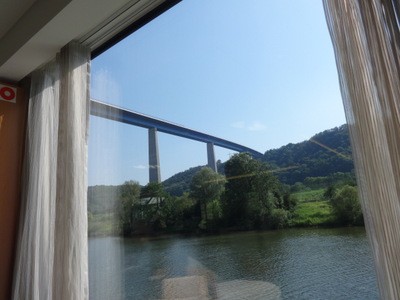 At the left is a random castle we passed on the way. We were always passing castles, large and small, often when no one was around to identify them.
At the left is a random castle we passed on the way. We were always passing castles, large and small, often when no one was around to identify them.
As we approached Winnegen, we passed under this gigantic modern freeway overpass.
We docked in Winnegen at 6 p.m., and shortly thereafter Devin delivered the day's briefing—information about tomorrows activities—and dinner was at 7 p.m.
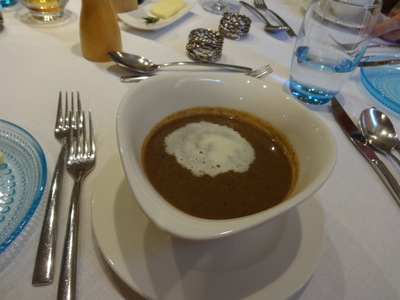
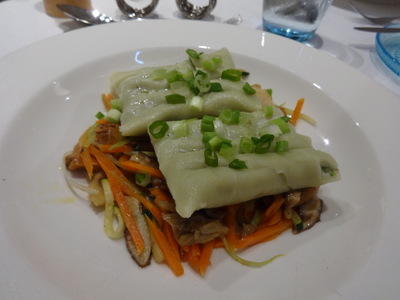 I had two of the "regional specialties," wild mushroom soup with truffle cream and "maultaschen" (feedbags), rectangular stuffed dumplings, in this case stuffed with goat cheese and spinach.
I had two of the "regional specialties," wild mushroom soup with truffle cream and "maultaschen" (feedbags), rectangular stuffed dumplings, in this case stuffed with goat cheese and spinach.
The soup was good. The dumplings bot so much. Again, heavy and gummy. I could probably do a better job myself, using my potato gnocchi recipe.
Other starter choices were beef salad over sliced dumplings (on someone else's plate, I recognized slices of the leftovers from the dumpling trio of earlier in the week) and Waldorf salad. After tasting the maultaschen, I wished I'd ordered the seared cod fillet or the osso bucco alla Milanese.
I had ice cream for dessert. I did not come to Europe to eat "New York Cheesecake" (or for that matter, Waldorf salad)!
In the course of the day, I spotted a little scroph I would call "butter-and-eggs, more of that yarrow-like thing, small pink bachelor's button shaped composities, cow parsley, thistles, pretty pink mallows, a couple of stalks of what might have been Liatris, and on the tops of the locks, right up against the ship's windows, yellow-blooming Sedum.
At 9 p.m. in the lounge, Devin and Sandrine (head of hotel services) led a round of "Majority Rules." David wasn't interested and went back to his stateroom, but I joined a group we'd had dinner and dinner and pleasant chats with. Devin would pose a question, like "Who's the best female actor of all time?" or "who is the most popular member of the ship's crew?," and each team (there were nine or ten) would arrive at an answer. Teams that gave the answer given by a majority of the teams won a point. Much laughter as the answers were revealed. We came in second.
Previous entry
List of Entries
Next entry

 As scheduled, the Kvasir docked in Cochem at 7 a.m., just as breakfast opened. Here's my breakfast plate (well, one of them), bearing, clockwise from 12 o'clock, a little red fruit pastry (not as good as it looked); some watermelon; a piece of cheese; some smoked salmon with capers, red onion, cream cheese, chives, and lemon; some bread and butter to go with the cheese, and, the prize of the lot, a fat slice of blutwurst—blood sausage—crisped on the griddle. Boy was that good! I'm glad I went back for more, because it never showed up again. You can also see the single-serve little plastic tub out of which I had to pry my butter. Now why would an organization that provides smoked salmon ad lib, morning after morning, be so miserly with butter? At dinner, each table for four was provided with four neat pats of butter on a plate, garnished with a rosemary sprig; at least they weren't plastic-wrapped.
As scheduled, the Kvasir docked in Cochem at 7 a.m., just as breakfast opened. Here's my breakfast plate (well, one of them), bearing, clockwise from 12 o'clock, a little red fruit pastry (not as good as it looked); some watermelon; a piece of cheese; some smoked salmon with capers, red onion, cream cheese, chives, and lemon; some bread and butter to go with the cheese, and, the prize of the lot, a fat slice of blutwurst—blood sausage—crisped on the griddle. Boy was that good! I'm glad I went back for more, because it never showed up again. You can also see the single-serve little plastic tub out of which I had to pry my butter. Now why would an organization that provides smoked salmon ad lib, morning after morning, be so miserly with butter? At dinner, each table for four was provided with four neat pats of butter on a plate, garnished with a rosemary sprig; at least they weren't plastic-wrapped.
 Even after the bus ride up the hill, we still had to climb a good way up this stone ramp (of which you can only see part; it had a couple of switchbacks in it), past two coats of armor guarding the archway, past several gardeners industriously planting colorful flowers, and finally in through this covered wooden door to the courtyard.
Even after the bus ride up the hill, we still had to climb a good way up this stone ramp (of which you can only see part; it had a couple of switchbacks in it), past two coats of armor guarding the archway, past several gardeners industriously planting colorful flowers, and finally in through this covered wooden door to the courtyard.
 Here's the floorplan and map the guide pointed out. The place is a very complicated shape and includes many changes in elevation. I think the bus dropped us at the lower right corner and that we climbed to the left, then switched back to the right, and finally bore left through the wooden arch.
Here's the floorplan and map the guide pointed out. The place is a very complicated shape and includes many changes in elevation. I think the bus dropped us at the lower right corner and that we climbed to the left, then switched back to the right, and finally bore left through the wooden arch.
 The indoor tour started with this dining room. Note the heavy ornately carved chairs, the china cupboard at the far end, the painted wooden ceiling reminiscent of that at Wakulla Springs Lodge, and particularly the drinking horn on the center of the table.
The indoor tour started with this dining room. Note the heavy ornately carved chairs, the china cupboard at the far end, the painted wooden ceiling reminiscent of that at Wakulla Springs Lodge, and particularly the drinking horn on the center of the table.
 Here's a better view of the ceiling. No egrets or blue herons on it, but you can see the kinship with the Wakulla ceiling.
Here's a better view of the ceiling. No egrets or blue herons on it, but you can see the kinship with the Wakulla ceiling.
 The next room had no furniture in it, but it featured this fireplace with a Gothic style mantlepiece and Delft tiles that are over 150 years old.
The next room had no furniture in it, but it featured this fireplace with a Gothic style mantlepiece and Delft tiles that are over 150 years old.
 Another room featured this green tiled stove (I think he said Nuremberg style?), with more Delft tiles on the wall behind it to protect the wall from the heat. It was on four legs and didn't actually touch the wall. It seemed to be stoked through a little metal door near the bottom on the left-hand side rather than from behind through the wall, like some we've seen.
Another room featured this green tiled stove (I think he said Nuremberg style?), with more Delft tiles on the wall behind it to protect the wall from the heat. It was on four legs and didn't actually touch the wall. It seemed to be stoked through a little metal door near the bottom on the left-hand side rather than from behind through the wall, like some we've seen.
 Under a barrel-vaulted wooden ceiling hung this remarkable object. There used to be one in a German restaurant in Chapel Hill, and we've seen several in other castles we've toured over the years. Her presence is supposed to ward off evil and protect the castle, but I've never really understood the concept. Why a mermaid with antlers? And why are the antlers attached at her hips rather than on her head or even shoulders? Bizarre? Any of you readers out there have a clue?
Under a barrel-vaulted wooden ceiling hung this remarkable object. There used to be one in a German restaurant in Chapel Hill, and we've seen several in other castles we've toured over the years. Her presence is supposed to ward off evil and protect the castle, but I've never really understood the concept. Why a mermaid with antlers? And why are the antlers attached at her hips rather than on her head or even shoulders? Bizarre? Any of you readers out there have a clue?
 The trophy room contained large number of mounted heads and disembodied antlers, some quite large like the wild boar at the right, and others not, like the tiny stuffed weasel, smaller than a squirrel.
The trophy room contained large number of mounted heads and disembodied antlers, some quite large like the wild boar at the right, and others not, like the tiny stuffed weasel, smaller than a squirrel.
 In another room furnished for dining was this much more modern-looking arrangement of table and chairs.
In another room furnished for dining was this much more modern-looking arrangement of table and chairs.
 In the smoking room, distinguished by its tiled rather than wooden or carpeted floor, was this huge suit of armor, 50% bigger than any of the others. The guy wearing it would have been 2 m 38 cm (7.8 ft!) tall. The guide told us that the military salute derives from the gesture of raising the visor of your helmet. The smoking room also included a 16th-century marquetry wardrobe in blond wood. Beautiful.
In the smoking room, distinguished by its tiled rather than wooden or carpeted floor, was this huge suit of armor, 50% bigger than any of the others. The guy wearing it would have been 2 m 38 cm (7.8 ft!) tall. The guide told us that the military salute derives from the gesture of raising the visor of your helmet. The smoking room also included a 16th-century marquetry wardrobe in blond wood. Beautiful.
 The castle has over 40 rooms, of which we visited only 7. On our way out through the courtyard, we stopped to look at the well (essential, of course if the castle were to withstand sieges). It was dug 1000 years ago, through solid slate, and is 5 m deep.
The castle has over 40 rooms, of which we visited only 7. On our way out through the courtyard, we stopped to look at the well (essential, of course if the castle were to withstand sieges). It was dug 1000 years ago, through solid slate, and is 5 m deep.
 In other directions were this picturesque view of a wing of the castle and the view of the town's technical high school, on the hillside below the castle. We were told that a school bus runs up and down the river picking up students but that it drops them off down in the town and the students have to climb the hill on foot to get to classes.
In other directions were this picturesque view of a wing of the castle and the view of the town's technical high school, on the hillside below the castle. We were told that a school bus runs up and down the river picking up students but that it drops them off down in the town and the students have to climb the hill on foot to get to classes.
 The bus took us partway down the hill, but the walking tour of the town on the way back to the ship still tool us down some impressive slopes, like this "street." Cochem still has its medieval-era walls, so as you walk around in it, you pass through quite a lot of gates in it. That's one partway down the stairs.
The bus took us partway down the hill, but the walking tour of the town on the way back to the ship still tool us down some impressive slopes, like this "street." Cochem still has its medieval-era walls, so as you walk around in it, you pass through quite a lot of gates in it. That's one partway down the stairs.
 At the left here is the "Fuchlach," the foxhole, the smallest gate in the town's walls. To reach the street on the other side, we had to duck through it and an short curved tunnel.
At the left here is the "Fuchlach," the foxhole, the smallest gate in the town's walls. To reach the street on the other side, we had to duck through it and an short curved tunnel.
 Near the end of the tour was this magnificent 1982 sculpture/mosaic of the town's time line. My photo is way to small to show the details, but inscriptions in the clay explain the parts. At the top, for example, one says "Celts, Romans, Franconians" and names four Roman legions that were apparently garrisoned here. You can see some Roman amphorae near the top left.
Near the end of the tour was this magnificent 1982 sculpture/mosaic of the town's time line. My photo is way to small to show the details, but inscriptions in the clay explain the parts. At the top, for example, one says "Celts, Romans, Franconians" and names four Roman legions that were apparently garrisoned here. You can see some Roman amphorae near the top left. 
 On the way, our Viking guide pointed out an innovaion in the vineyards. They are so steep that all the work of pruning, harvesting, etc. must be done by hand, but in some areas, the growers have installed what you see here at the left—little monorails that can be used to haul equipment (and presumably filled bins of harvested grapes) up and down the hills.
On the way, our Viking guide pointed out an innovaion in the vineyards. They are so steep that all the work of pruning, harvesting, etc. must be done by hand, but in some areas, the growers have installed what you see here at the left—little monorails that can be used to haul equipment (and presumably filled bins of harvested grapes) up and down the hills.
 Inside were even more! Every room we were shown was entirely wallpapered in antique grape-growing and wine-making tools! I love that kind of thing, and I wish we'd had time to look at them all, read the labels, and ask questions.
Inside were even more! Every room we were shown was entirely wallpapered in antique grape-growing and wine-making tools! I love that kind of thing, and I wish we'd had time to look at them all, read the labels, and ask questions.
 Finally, it was back into the bus for the ride back to the ship for lunch. I just had the salad bar, which included smoked duck breast with orange slices (top left corner of the plate) and slices of bread topped with cucumber and shrimp.
Finally, it was back into the bus for the ride back to the ship for lunch. I just had the salad bar, which included smoked duck breast with orange slices (top left corner of the plate) and slices of bread topped with cucumber and shrimp.
 I then went on to the pasta station for papardelle with wild mushroom ragout.
I then went on to the pasta station for papardelle with wild mushroom ragout. At the left is a random castle we passed on the way. We were always passing castles, large and small, often when no one was around to identify them.
At the left is a random castle we passed on the way. We were always passing castles, large and small, often when no one was around to identify them.
 I had two of the "regional specialties," wild mushroom soup with truffle cream and "maultaschen" (feedbags), rectangular stuffed dumplings, in this case stuffed with goat cheese and spinach.
I had two of the "regional specialties," wild mushroom soup with truffle cream and "maultaschen" (feedbags), rectangular stuffed dumplings, in this case stuffed with goat cheese and spinach.